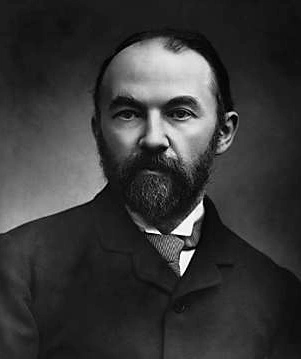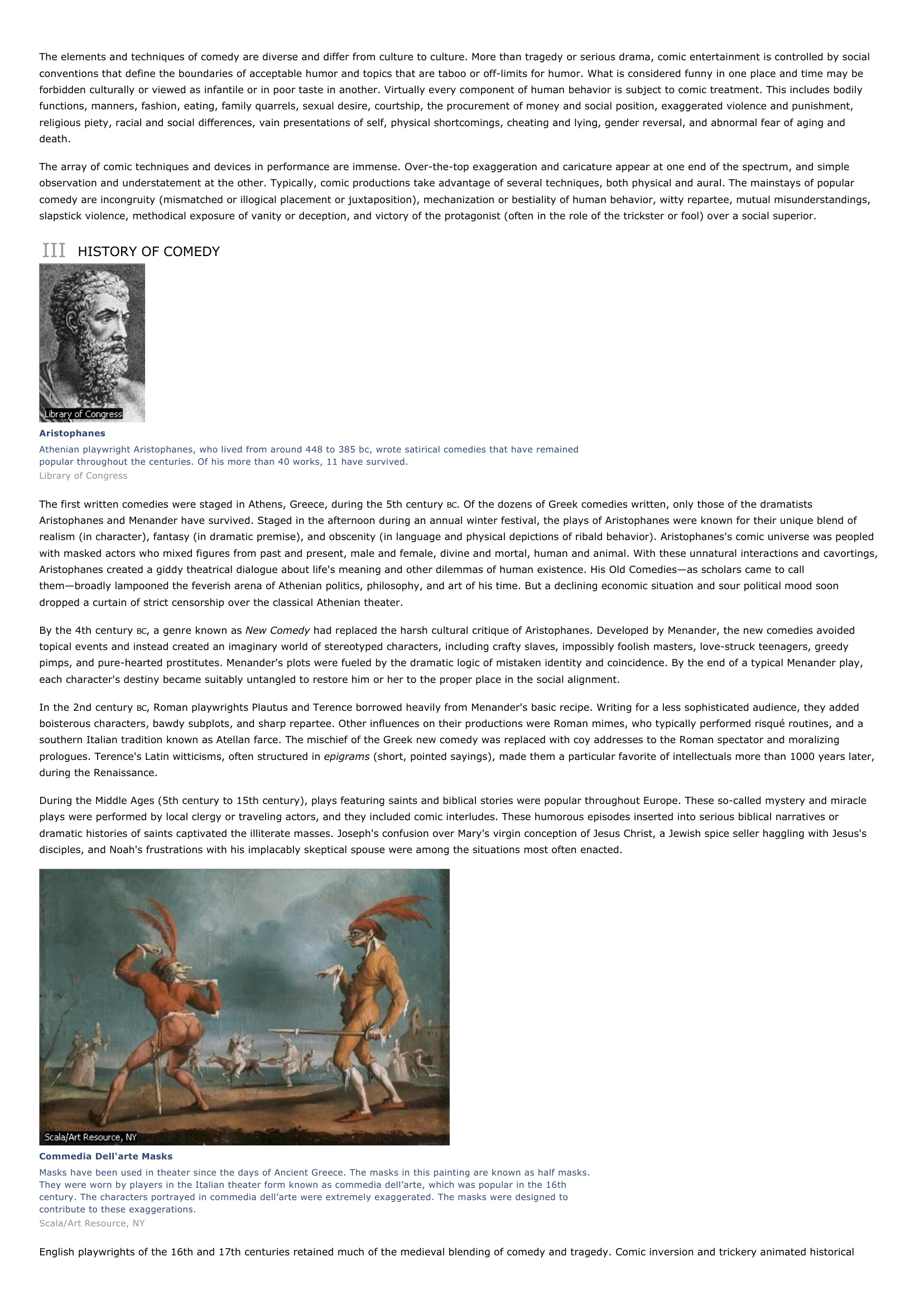Comedy I INTRODUCTION Laurel and Hardy Stan Laurel, in overalls, and Oliver Hardy, left, formed one of the most popular comedy teams in motion-picture history.
Publié le 12/05/2013

Extrait du document


«
The elements and techniques of comedy are diverse and differ from culture to culture.
More than tragedy or serious drama, comic entertainment is controlled by socialconventions that define the boundaries of acceptable humor and topics that are taboo or off-limits for humor.
What is considered funny in one place and time may beforbidden culturally or viewed as infantile or in poor taste in another.
Virtually every component of human behavior is subject to comic treatment.
This includes bodilyfunctions, manners, fashion, eating, family quarrels, sexual desire, courtship, the procurement of money and social position, exaggerated violence and punishment,religious piety, racial and social differences, vain presentations of self, physical shortcomings, cheating and lying, gender reversal, and abnormal fear of aging anddeath.
The array of comic techniques and devices in performance are immense.
Over-the-top exaggeration and caricature appear at one end of the spectrum, and simpleobservation and understatement at the other.
Typically, comic productions take advantage of several techniques, both physical and aural.
The mainstays of popularcomedy are incongruity (mismatched or illogical placement or juxtaposition), mechanization or bestiality of human behavior, witty repartee, mutual misunderstandings,slapstick violence, methodical exposure of vanity or deception, and victory of the protagonist (often in the role of the trickster or fool) over a social superior.
III HISTORY OF COMEDY
AristophanesAthenian playwright Aristophanes, who lived from around 448 to 385 bc, wrote satirical comedies that have remainedpopular throughout the centuries.
Of his more than 40 works, 11 have survived.Library of Congress
The first written comedies were staged in Athens, Greece, during the 5th century BC.
Of the dozens of Greek comedies written, only those of the dramatists Aristophanes and Menander have survived.
Staged in the afternoon during an annual winter festival, the plays of Aristophanes were known for their unique blend ofrealism (in character), fantasy (in dramatic premise), and obscenity (in language and physical depictions of ribald behavior).
Aristophanes's comic universe was peopledwith masked actors who mixed figures from past and present, male and female, divine and mortal, human and animal.
With these unnatural interactions and cavortings,Aristophanes created a giddy theatrical dialogue about life's meaning and other dilemmas of human existence.
His Old Comedies—as scholars came to callthem—broadly lampooned the feverish arena of Athenian politics, philosophy, and art of his time.
But a declining economic situation and sour political mood soondropped a curtain of strict censorship over the classical Athenian theater.
By the 4th century BC, a genre known as New Comedy had replaced the harsh cultural critique of Aristophanes.
Developed by Menander, the new comedies avoided topical events and instead created an imaginary world of stereotyped characters, including crafty slaves, impossibly foolish masters, love-struck teenagers, greedypimps, and pure-hearted prostitutes.
Menander's plots were fueled by the dramatic logic of mistaken identity and coincidence.
By the end of a typical Menander play,each character's destiny became suitably untangled to restore him or her to the proper place in the social alignment.
In the 2nd century BC, Roman playwrights Plautus and Terence borrowed heavily from Menander's basic recipe.
Writing for a less sophisticated audience, they added boisterous characters, bawdy subplots, and sharp repartee.
Other influences on their productions were Roman mimes, who typically performed risqué routines, and asouthern Italian tradition known as Atellan farce.
The mischief of the Greek new comedy was replaced with coy addresses to the Roman spectator and moralizingprologues.
Terence's Latin witticisms, often structured in epigrams (short, pointed sayings), made them a particular favorite of intellectuals more than 1000 years later, during the Renaissance.
During the Middle Ages (5th century to 15th century), plays featuring saints and biblical stories were popular throughout Europe.
These so-called mystery and miracleplays were performed by local clergy or traveling actors, and they included comic interludes.
These humorous episodes inserted into serious biblical narratives ordramatic histories of saints captivated the illiterate masses.
Joseph's confusion over Mary's virgin conception of Jesus Christ, a Jewish spice seller haggling with Jesus'sdisciples, and Noah's frustrations with his implacably skeptical spouse were among the situations most often enacted.
Commedia Dell'arte MasksMasks have been used in theater since the days of Ancient Greece.
The masks in this painting are known as half masks.They were worn by players in the Italian theater form known as commedia dell’arte, which was popular in the 16thcentury.
The characters portrayed in commedia dell’arte were extremely exaggerated.
The masks were designed tocontribute to these exaggerations.Scala/Art Resource, NY
English playwrights of the 16th and 17th centuries retained much of the medieval blending of comedy and tragedy.
Comic inversion and trickery animated historical.
»
↓↓↓ APERÇU DU DOCUMENT ↓↓↓
Liens utiles
- Charlie Chaplin Charlie Chaplin (1889-1977), English motion-picture actor, director, producer, and composer, one of the most creative artists in film history, who first achieved worldwide fame through his performances in silent films.
- Musical I INTRODUCTION George Gershwin American pianist, songwriter, and composer George Gershwin was one of the most important figures in popular song in the 1920s and 1930s.
- Frank Sinatra Frank Sinatra (1915-1998), Italian American singer and motion-picture actor, one of the most famous American entertainers of his generation.
- Charles Dickens I INTRODUCTION Charles Dickens English author Charles Dickens ranks as one of the most popular writers in the history of world literature.
- Shirley Temple Shirley Temple, born in 1928, American motion-picture actor, considered one of the most successful child stars in the history of film.








